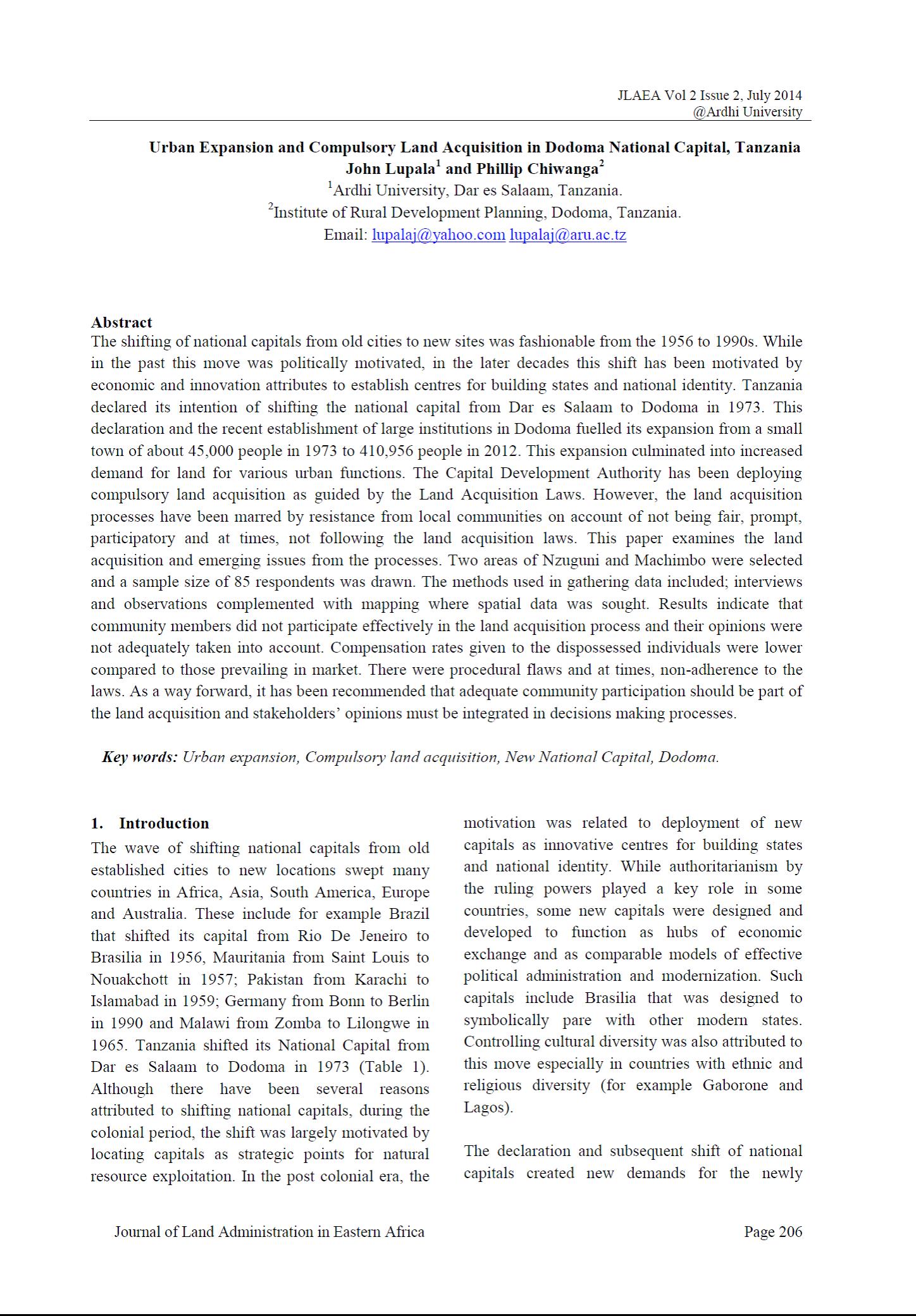This article discusses how one group is contributing to critical thinking about how the Voluntary Guidelines for the Responsible Governance of Tenure of Land, Fisheries, and Forests in the Context of National Food Security (VGs) are implemented. The Future Agricultures Consortium (FAC) - an Africa-based alliance of agricultural research organizations - is both tracking implementation of the VGs and launching a study that will, among other things, investigate the multiple pressures toward the commercialization of land and the resulting impacts on land rights in Southern Africa.
Search results
Showing items 1 through 9 of 336.-
Library ResourceJournal Articles & BooksMarch, 2013Malawi, Mozambique, Zambia, Zimbabwe, Namibia
-
Library ResourceJournal Articles & BooksJanuary, 2010Kenya
In land administration (LA), the right to exercising property/ownership rights on land is based on cadastral processes of adjudication, survey and rights registration. Private ownership rights are now being taken up in pastoral areas, where they must contend with pastoralists’ land rights. Pastoral land use
-
Library ResourceJournal Articles & BooksSeptember, 2016Tanzania
The year 2016 marks 15 years since the new wave land reforms became operational in Tanzania. Despite its ambitious goals – encouraging land registration and titling, and empowering women and other vulnerable groups – the results are disillusioning. A brief overview of 15 years of implementation, using the Village Land Act as a case study.
-
Library ResourceJournal Articles & BooksJuly, 2013Eastern Africa
This paper looks at Valuation as an important component of land administration that has outgrown the land sector gradually becoming an independent professional discipline much to the chagrin of its hosts – the land administration. Valuation as a profession originated in the actual sale transactions in medieval Europe where buyers relied on experienced interventionists in the land/real estate market to advise on the size and buying price of real properties. Its eventual introduction to university curriculum has been diverse amongst different regions and at varying momentum.
-
Library Resource
The Case of Kibamba Dar Es Salaam
Journal Articles & BooksJuly, 2013TanzaniaThe future is increasingly urban and inevitably so. Urbanisation is increasing at unprecedented rate in both Sub-Saharan Africa and developing world (UN Habitat, 1999). Alongside this rapid expansion comes the emergence of the peri-urban areas that are characterised of increasing intensification and co-existence of urban and rural areas, marked by dynamic flows of commodities, capital, natural resources, people and environmental pollution.
-
Library ResourceJournal Articles & BooksJuly, 2013Tanzania
The history of surveys and mapping in Tanzania has been influenced by two European cultures through its colonization; first by the German and then by the British. During the German Administration, surveys and mapping activities were carried out by the Department of Surveys and Agriculture from 1893 to 1914. When the British took over the mandate for the territory after World War I, the also used the “old” German maps until when they when they started the surveys to produce other topographic maps from 1946. In 1961, the Surveys and Mapping Division was created.
-
Library ResourceJournal Articles & BooksJanuary, 2014Tanzania
The aim of this paper is to compute a more accurate orthometric height of Mount Kilimanjaro by utilizing the current most precise geoid model for Tanzania, TZG08, together with the 1999 and 2008 GPS campaigns ellipsoidal heights using GPS levelling method.
The result of the GPS levelling using TZG08 gravimetric geoid model and the Kil_1999 and KILI2008 GPS ellipsoidal heights is that the orthometric height of Mount Kilimanjaro is 5,894.94m. Therefore the orthometric height of Mount Kilimanjaro is practically the same as the 1952 official height of 5,895m.
-
Library Resource
A Strategy Towards Reliable Food Security Information & Early Warning Systems (FSIEWS) For Tanzania
Journal Articles & BooksJanuary, 2014TanzaniaThe practice of food security assessment in Tanzania is based on use of food crops production data surveys of a preceding seasonal year with agro-meteorological analyses based on estimated vegetation status as reflected from NDVI computed from NOAA satellite images. Food security assessment essentially is a prediction of food availability in predefined future time framework. It helps to establish availability or deficiency of food, thereby facilitating planning and implementation of strategies to mitigate the problem of hunger.
-
Library ResourceJournal Articles & BooksJanuary, 2014Tanzania
The concept in this paper builds upon basic principles of sustainability to address the problem of how a sustainable project must contribute to economic and social welfare without depleting natural resources, destroying the environment or harming human health.. With this understanding, a systems approach was used in a study that conceptualised a paradigm shift in project management system for sustainability incorporating Environmental Impact Assessment (EIA), Cause-effect Chain and the Socio-economic Resource models.
-
Library ResourceJournal Articles & BooksJuly, 2014Tanzania
The shifting of national capitals from old cities to new sites was fashionable from the 1956 to 1990s. While in the past this move was politically motivated, in the later decades this shift has been motivated by economic and innovation attributes to establish centres for building states and national identity. Tanzania declared its intention of shifting the national capital from Dar es Salaam to Dodoma in 1973. This declaration and the recent establishment of large institutions in Dodoma fuelled its expansion from a small town of about 45,000 people in 1973 to 410,956 people in 2012.
Land Library Search
Through our robust search engine, you can search for any item of the over 64,800 highly curated resources in the Land Library.
If you would like to find an overview of what is possible, feel free to peruse the Search Guide.









